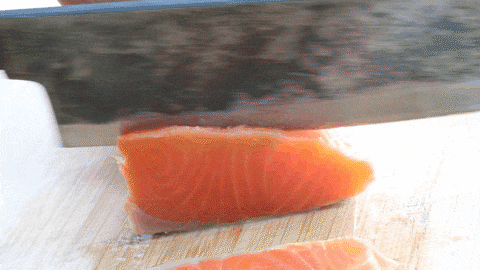KUROUCHI KNIFE:Black hammered blade
A traditionally made Kurouchi Kitchen Knife
Using traditional crafting methods, a handmade Kurouchi Santoku knife! Utilizing skills that make true Japanese swords!
Using crafting methods since ancient times, Japanese blades are well sought after all over the world. The crafting methods that are used to create true Japanese blades have been passed down from generation to generation, and only the craftsmen that have learnt these techniques can be said to have made true Japanese blades. The Kurouchi knife is a true Japanese blade that has been made using these sword making techniques, which have an outstanding sharpness. With the hammer marked ruggedness and an oxidised black face, this is a truly traditional Japanese Kitchen knife, that has been made with the soul of the craftsman poured into it.
We want to bring more attention to the status of Japanese craftsmen, and so we look to promote products that use these amazing traditional techniques. We hope that with this project, we can put a spotlight on the brilliant craftsmanship that goes into making these amazing items.
With an emphasis on the sharpness of the knife, this is a true Japanese blade, with the heart of the craftsman being poured into each knife.
The secret behind the sharpness is the warikomi style, or wedging of metal between metal, alongside the quenching process.
A warikomi wedging manufacturing process
Warikomi is a process where a core of one metal is wedged between a different metal. By sandwiching a harder but brittler steel between a soft and more malleable iron, it allows the knife to become both flexible while also being hard. This means that the edge of the blade can be made using the harder material, which only needs to be sharpened once to hold its edge for longer while keeping sharp, making it a great, easy to use blade.
Water quenching
To create a core that is hard and persistent, which helps to improve the cutting edge of the knife, a lot of hammering is needed during the process of forging. It is a process that follows the tempering process in order to make the blade harder. There are two main types of doing so, oil quenching and water quenching, with water quenching being the more complex of the two, as it deals with rapid cooling, which results in minute difference in the steel's hardness, which means it can hold its edge longer.
A smooth cutting edge
By leaving the surface of the blade with the blackened surface, it protects against rusting, and the uneven hammered marks meaning that the food can’t stick easily to the surface of the blade, making a cutting through things a breeze.
The edge of the blade is sharp enough to cut ingredients thinly.
A safe to use knife
There is little risk to the film coming off and if it does somehow get striped, then it won’t cause any harm to the body.
There is a well known steel in the knife industry that is called Aogami, or Blue Paper steel. Produced by Proterial Yasugi, which used to be Hitachi Metal works. Located in the Izumo region, Shimane Prefecture, they have been a famous producer of the tamahagange, or traditional Japanese steel made from iron sand, for Japanese swords since long ago.
The tamahagane from this region is extremely high quality, and has been shipped all around Japan to be used as material for Japanese swords as well as cutlery.
The Aogami Steel is made by combining the Shirogami no.2 version of their steel with chrome and tungsten, which leads to a more balanced steel that holds its edge, while also being easy to heat treat.
It is popular for pro chef knives as it is a high grade stainless steel that is resistant to wear and tear and has a persistent edge. It is also easy to sharpen as well as durable, perfect for kitchen knives.








